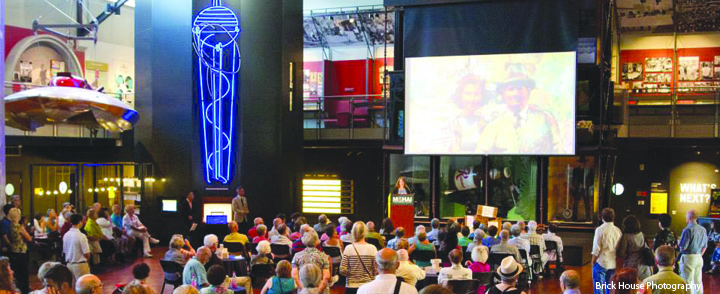By Boris Kurbanov, Special to The Jewish Sound
The history and tales of Jewish immigration to Washington is documented in an exhibit now on display at Seattle’s Museum of History and Industry.
“Shalom! Open for Business: Tales of Jewish Merchants in Washington State” is a joint project of the Washington State Jewish Historical Society and MOHAI, and will be on display through January 15, 2015.
Representing more than 100 families, the exhibit, which opened July 27, chronicles the story of Washington’s Jewish pioneers through first-person accounts, historic photos, and artifacts from family collections, as well as captivating vignettes and interactive displays. The body of research mostly came from the Jewish archives at the University of Washington; nearly 500 oral histories are included.
Lisa Kranseler, executive director of the WSJHS, first approached MOHAI years ago to find a home for a Jewish history exhibit.
“We don’t have a Jewish history museum in our state, and we are one of the only cities [in the United States] of Seattle’s size without a Jewish history museum,” Kranseler said. “I have not let that be an obstacle, and made my case to MOHAI that there’s no better exhibit that meets both our mission and their mission.”
The original exhibit this one is based upon was open for one day at Congregation Ezra Bessaroth in 2009. Titled “Who’s Minding the Store?” it featured 170 stories of early Jewish businesses, including first-person accounts and family interviews. The exhibit then briefly toured at Temple de Hirsch Sinai, as well as synagogues in Tacoma, Whidbey Island and Spokane.
Still, the questions and demands for a place to tell this important story in Seattle came often. Kranseler decided the exhibit needed to be re-curated.
“People called — and continue to call — our office all the time and ask, ‘Where can we see or learn about the Jewish history of Washington?’ Kranseler said. “We have extensive archives available at the University of Washington, but you’re just not getting an exhibit-type of experience.”
Curated by Stuart Ezkenazi with a thematic approach, the exhibit’s centerpiece is a canvas painting depicting a collage of early Jewish business owners, the work of Seattle-based artist Joanne Shellan, whose parents fled Hitler’s Germany and immigrated to New York before heading west and settling in Washington State in 1949. They would later open a jewelry store in the Skagit Valley.
“Joanne did a beautiful interpretation of what the exhibit is about,” Eskenazi said. “History museums don’t necessarily have original artwork that is part of the display, but we’re really happy this is the first thing people see when they walk through the door.”
The goal is to highlight the vibrant traditions and history of Seattle’s original community, while tracing their history and describing the difference between the four waves of immigration, including those who made their way from Eastern Europe, Central Europe, the Ladino-speaking Jews of Rhodes and Turkey and those who escaped Nazi Germany, ultimately making a name for themselves and earning a living as butchers, jewelers, bakers and luggage makers, among many other professions.
“I empathize with what it took for my parents and other Jewish immigrants to rise above their circumstances,” Shellan wrote in her artist statement. “Most arrived in the U.S. with few connections. A couple of battered suitcases and their wits were about all they had. In every single one of their faces, I see pride in overcoming that struggle — and in becoming a merchant within the promising democracy of America.”
In addition to facing language barriers, most early settlers had little to no education, and were viewed as outsiders, Eskenazi said.
“That’s often the immigrant experience. America is, for the most part, a country of immigrants,” he said. “Apart from the Native Americans, we are all immigrants, and hopefully people — whether they’re Jewish, Catholic, Muslim — will relate to these stories. We want it to resonate with everybody.”
Merchants, many of whom were denied citizenship in New York City and other cities on the East Coast who were no longer accepting immigrants, headed west. For them, Washington State was full of promise because of what was going on with the Klondike gold rush in Alaska, as well as the construction of a new railroad.
“There was certainly a lot of opportunity here: Seattle was a young city, Washington was still a fairly young state and they came here to build their businesses around a set of values: integrity, compassion, hard work, enterprise and family,” Eskenazi said.
The settlers created businesses that reflected the trades and professions they knew from back home, but also to specifically to serve the Jewish immigrant community.
“What I really want is for people to see themselves within those stories of the merchants that are told in the gallery,” Eskenazi said. “I would hope those who visit understand that not all Jews are from New York, and that there was a vibrant Jewish community here in Seattle consisting of four different groups of immigrants, who, in spite of their differences, were able to create this thriving community.”
“This is a universal immigrant story that is not only relevant to the Jewish people, but one that could be applied to almost any immigrant group,” Kranseler said. “All these groups have a similar story to tell — we are telling the Jews’ story. To get an understanding of what our ancestors went through — with all the obstacles they had — is an incredible lesson for us all.”
If you go: MOHAI is open 10 a.m. to 5 p.m. daily and until 8 p.m. Thursdays. Admission is free on the first Thursday of every month, and is free for children under 14. Prices range $14 to $17. For more information, call 206-324-1126 or visit www.mohai.org.
